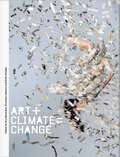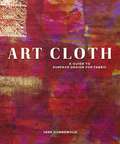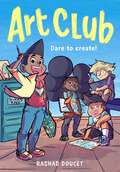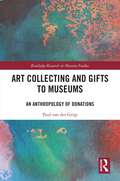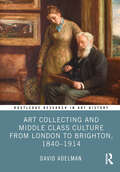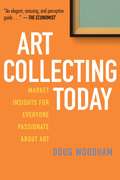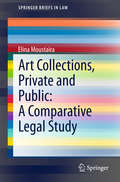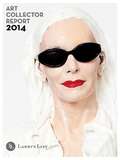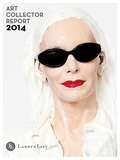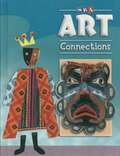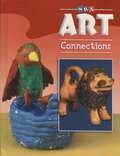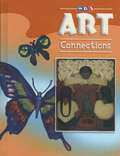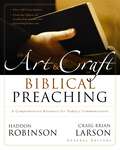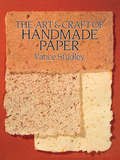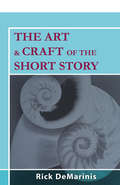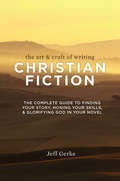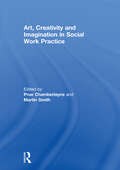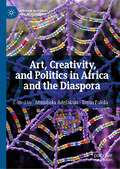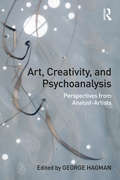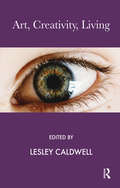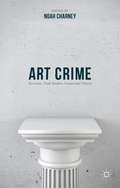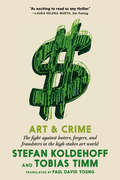- Table View
- List View
Art + Climate = Change
by Guy Abrahams Kelly Gellatly Bronwyn JohnsonIn a period of profound environmental and social upheaval, climate change has become one of our greatest challenges. Yet for many of us, fear, confusion and frustration mean we are reluctant to consider, let alone act on this pressing issue.Rational engagement with science is vital to forming solutions to this challenge. But a cultural shift is also needed. Artists have the capacity to develop a narrative that recognises the reality of our present and inspires a vibrant, positive vision of our future.Presenting the work of Australian and international artists across twenty-nine exhibitions and events, ART+CLIMATE=CHANGE explores the power of art to create the empathy, emotional engagement and cultural understanding needed to motivate meaningful change.
Art Cloth
by Jane DunnewoldThis information-packed handbook is appropriate for both newcomers and experienced dyers but assumes that readers have a serious interest in textile design.
Art Cloth
by Jane DunnewoldThis information-packed handbook is appropriate for both newcomers and experienced dyers but assumes that readers have a serious interest in textile design.
Art Club (A Graphic Novel)
by Rashad DoucetInspired by the author&’s own childhood, this contemporary graphic novel paints a picture of an aspiring young artist on a mission to prove that the arts are worth fighting for. Dale Donavan has heard the same lecture over and over again: Art will get you nowhere in life. A kid with a creative streak, Dale wants nothing more than to doodle, play video games, and create comics forever—maybe even as a full-time job one day. But between his grandfather pushing him to focus on his studies and a school with zero interest in funding arts programs, Dale feels like his future has already been decided for him. That is, until he comes up with the perfect plan: What if he starts an after-school art club, gathers a team of creative students like himself, and proves all the naysayers—his stubborn vice principal in particular—wrong? This might just work, but if the club isn&’t financially successful by the end of the semester, the school with shut them down. This may be Dale&’s only chance to show the adults in his life that a career as an artist is not just a dream but a possibility!
Art Collecting and Gifts to Museums: An Anthropology of Donations (Routledge Research in Museum Studies)
by Paul van der GrijpArt Collecting and Gifts to Museums questions why private collectors donate their collection, or parts of it, to museums and examines what the implications of this gifting process might be.Presenting case studies from Europe, North America, East Asia, and the South Pacific, this book is concerned with both elite and popular collections and examines the act of donating art from the collector’s point of view. Demonstrating that art museums depend on donations from private collectors, Paul van der Grijp emphasizes that it is crucial to understand the psychological, sociological, economic, and educational motivations for gifting works of art to institutions. Taken together, the chapters argue that collectors donate to museums because the latter represent an imagined community, to whom those collectors would like to bestow a sacred gift. Private collectors are, Van der Grijp maintains, motivated to ensure the immortality of their collections and, ultimately, to preserve some memory of their own lives in the process.Art Collecting and Gifts to Museums will be of interest to researchers and students engaged in the study of museums, culture, art, anthropology, history, and sociology.
Art Collecting and Middle Class Culture from London to Brighton, 1840–1914 (Routledge Research in Art History)
by David AdelmanThis study explores the interplay between money, status, politics and art collecting in the public and private lives of members of the wealthy trading classes in Brighton during the period 1840–1914.Chapters focus on the collecting practices of five rich and upwardly mobile Victorians: William Coningham (1815–84), Henry Hill (1813–82), Henry Willett (1823–1905) and Harriet Trist (1816–96) and her husband John Hamilton Trist (1812–91). The book examines the relationship between the wealth of these would-be members of the Brighton bourgeoisie and the social and political meanings of their art collections paid for out of fortunes made from sugar, tailoring, beer and wine. It explores their luxury lifestyles and civic activities including the making of Brighton museum and art gallery, which reflected a paradoxical mix of patrician and liberal views, of aristocratic aspiration and radical rhetoric. It also highlights the centrality of the London art world to their collecting facilitated by the opening of the London to Brighton railway line in 1841.The book will be of interest to scholars working in art history, museum studies and British history.
Art Collecting Today: Market Insights for Everyone Passionate about Art
by Doug WoodhamAn insider's guide to buying, collecting, and selling art from an insider of Christie's Grounded in real-life stories, Art Collecting Today is the essential practical guide to today's art market. A lightly regulated industry with more than sixty billion dollars of annual sales, the art market is often opaque and confusing to even the most experienced collectors. But whether a seasoned collector, an uninitiated newcomer, or an art-world insider, readers will learn within these pages how the art marketplace works in practice and how to navigate it smartly. Those who may have been put off by art-world practices will finally feel they have the knowledge needed to participate freely and fully, and collectors will be able to pursue their passion with more confidence. Important topics covered include:How to evaluate, buy, and sell art while avoiding costly mistakes and time-consuming roadblocks How the market works in practice for essential artists like Ren? Magritte, Christopher Wool, Amedeo Modigliani, and Yayoi Kusama How collectors can be taken advantage of, and the actions they should take to protect themselves Why tax laws in the United States reward "art investors" yet penalize "art collectors" How cultural property laws impact the market for works by such artists as Frida Kahlo and Andy Warhol Advice for new and prospective collectors Informed by close to one hundred interviews with collectors, lawyers, art advisors, gallerists, and auction specialists in the United States and Europe, as well as by the author's own experiences, Art Collecting Today offers a lively and thought-provoking analysis of the day-to-day workings at play today in the fine art marketplace.
Art Collections, Private and Public: A Comparative Legal Study (SpringerBriefs in Law)
by Elina MoustairaThis book is a comparative legal study of the private and public art collections in various states of the world, covering the most important issues that usually arise and focusing on the differences and the similarities of the national laws in the treatment of those issues.
The Art Collector in Early Modern Italy: Andrea Odoni and his Venetian Palace
by Monika SchmitterLorenzo Lotto's Portrait of Andrea Odoni is one of the most famous paintings of the Italian Renaissance. Son of an immigrant and a member of the non-noble citizen class, Odoni understood how the power of art could make a name for himself and his family in his adopted homeland. Far from emulating Venetian patricians, however, he set himself apart through the works he collected and the way he displayed them. In this book, Monika Schmitter imaginatively reconstructs Odoni's house – essentially a 'portrait' of Odoni through his surroundings and possessions. Schmitter's detailed analysis of Odoni's life and portrait reveals how sixteenth-century individuals drew on contemporary ideas about spirituality, history, and science to forge their own theories about the power of things and the agency of object. She shows how Lotto's painting served as a meta-commentary on the practice of collecting and on the ability of material things to transform the self.
Art Collector Report
by Larry'S ListThe Larry's List team consists of art market researchers from around the world. Currently, we have more than 20 nationalities, each researcher with a background in art history or experience with art dealing.Which city in the world has the highest density of 2014 contemporary art collectors? Which country?Why does Germany almost have as many private art museums as the us?And what are the future trends for the global collectors scene?What you get: Unique Information on Art Collectors! The report offers detailed information on leading art collectors around the world. Our researchers carefully selected the data manually.
Art Collector Report KINDLE EDITION
by Larry'S ListThe Larry's List team consists of art market researchers from around the world. Currently, we have more than 20 nationalities, each researcher with a background in art history or experience with art dealing.<P><P>Which city in the world has the highest density of 2014 contemporary art collectors? Which country?Why does Germany almost have as many private art museums as the us?And what are the future trends for the global collectors scene?What you get: Unique Information on Art Collectors! The report offers detailed information on leading art collectors around the world. Our researchers carefully selected the data manually.
Art Connections (Level #6)
by McGraw-HillThis textbook is about art, its history and culture, aesthetic perception, art criticism, etc.
Art Connections (Level #2)
by McGraw-HillArtists make art about many subjects. Subject matter is the content of an artist's work. For example, the subject of a painting can be a vase of flowers or a self-portrait. This subject matter is easy to see. The subject matter is harder to understand when the artwork stands for something beyond itself.
Art Connections (Level #5)
by Rosalind RagansArtists make art about many subjects. Subject matter is the content of an artist's work. For example, the subject of a painting can be a vase of flowers or a self-portrait. This subject matter is easy to see. The subject matter is harder to understand when the artwork stands for something beyond itself.
Art & Craft of Biblical Preaching: A Comprehensive Resource for Today's Communicators
by Haddon Robinson Craig Brian LarsonThe most complete practical encyclopedia ever on the practice of preaching based on articles from who's who of over a hundred respected communicators of Christian truth, edited by Haddon Robinson and Craig Brian Larson using significant resources from the ministries of Christianity Today International. Includes audio CD with preaching technique examples from the book.
The Art & Craft of Handmade Paper
by Vance StudleyIf you can chop vegetables and boil water, you can make paper. It's easy with this fascinating step-by-step guide to making paper with vegetable fibers. No special tools are required and quality results can be had in a very short time.The opening chapter of Vance Studley's clearly outlined, beautifully illustrated text introduces the reader to the origin and development of paper, describes its use in history, examines cultures that made paper and explains why quality paper is ideal for creative use.The author then shows you in detail how to make attractive and useful paper in a vast number of sizes, shapes, textures, and colors. Details of the papermaking process range from scissoring the raw material and beating the pulp, to blending the contents and forming, pressing, drying, and separating the sheets.Step-by-step instructions and over 160 sharply detailed illustrations introduce professional artists as well as students of all ages and levels of expertise to necessary materials, tools, and equipment. A final chapter suggests a variety of projects, including the compilation of a portfolio, creating papers for printmaking and drawing, and producing a collage from the designer's finished product.An invaluable book for the craftsperson interested in learning a satisfying and fascinating hobby, this comprehensive manual will also appeal to artists in search of distinctive papers and teachers looking for a refreshing change in classroom projects.
The Art & Craft of the Short Story
by Rick DemarinisThe Art & Craft of the Short Story explores every key element of short fiction, including story structure and form; creative and believable characters; how to begin and where to end; and the generation of ideas; as well as technical aspects such as point of view; plot; description and imagery; and theme. Examples from the work of a wide variety are used. The author includes five of his own stories to demonstrate these topics.
The Art & Craft of Writing Christian Fiction: The Complete Guide to Finding Your Story, Honing Your Skills, & Glorifying God i n Your Novel
by Jeff GerkeLet's face it: Christian fiction is fun. Even if you're writing a serious-minded study of man's inhumanity to man, there is something exhilarating about story; about creating people and worlds and events; about telling a tale that keeps readers enraptured and maybe - just maybe - leaves them fortified in their walk with Jesus.But for all of the fun, it's also hard work. There is skill involved in writing excellent Christian fiction. There is craftsmanship to be learned. And there are the long hours pounding away on a manuscript that, by the time you're done with it, has you convinced it's the worst piece of garbage ever penned by man.That's not even talking about trying to get your book published. It's a wonder anyone would choose such a way to spend otherwise useful time.So maybe you put your novel away for awhile. You've tried to do more sensible things with your spare moments. You've attempted to be engaged with workaday matters, laundry, and bills.But one day, a new story idea will pop into your head or you won't be able to stop hearing the voice of a character demanding to be written about. On that day, you'll be right back where you were, counting the cost of writing Christian fiction -- and loving it like nothing else.
Art, Creativity and Imagination in Social Work Practice.
by Prue Chamberlayne and Martin SmithHarnessing the inspiration available from the arts and the imagination brings to life sensitive and effective social work practice. Workers feel most satisfied while service users and communities are more likely to benefit when creative thinking can be applied to practice dilemmas. Drawing on contributions from Canada, England and Utrecht this book illustrates the transforming effect of creatively applied thinking to social problems. The first part of the book considers how use of the self can be enhanced by analytic reflection and application to difficulties facing individuals and communities. The second part shows psychodynamic theory to be a valuable aid when thinking about issues faced by social workers facing threats and accusations, therapeutic work with children and restorative youth justice. The third part of the book considers the implications of working with the arts in community settings – an ex-mining community in North West England, the Tate Gallery in London and the ‘cultural capital’ of Liverpool. Taken as a whole these chapters combine to inspire and provoke thought of how the arts and the imagination can be used creativity to help service users confronted by problems with living and the workers who attempt to get alongside them to think about these.This book was published as a special issue of the Journal of Social Work Practice.
Art, Creativity, and Politics in Africa and the Diaspora (African Histories and Modernities)
by Abimbola Adelakun Toyin FalolaThis book explores the politics of artistic creativity, examining how black artists in Africa and the diaspora create art as a procedure of self-making. Essays cross continents to uncover the efflorescence of black culture in national and global contexts and in literature, film, performance, music, and visual art. Contributors place the concerns of black artists and their works within national and transnational conversations on anti-black racism, xenophobia, ethnocentrism, migration, resettlement, resistance, and transnational feminisms. Does art by the subaltern fulfill the liberatory potential that critics have ascribed to it? What other possibilities does political art offer? Together, these essays sort through the aesthetics of daily life to build a thesis that reflects the desire of black artists and cultures to remake themselves and their world.
Art, Creativity, and Psychoanalysis: Perspectives from Analyst-Artists
by George HagmanArt, Creativity, and Psychoanalysis: Perspectives from Analyst-Artists collects personal reflections by therapists who are also professional artists. It explores the relationship between art and analysis through accounts by practitioners who identify themselves as dual-profession artists and analysts. The book illustrates the numerous areas where analysis and art share common characteristics using first-hand, in-depth accounts. These vivid reports from the frontier of art and psychoanalysis shed light on the day-to-day struggle to succeed at both of these demanding professions. From the beginning of psychoanalysis, many have made comparisons between analysis and art. Recently there has been increasing interest in the relationship between artistic and psychotherapeutic practices. Most important, both professions are viewed as highly creative with spontaneity, improvisation and aesthetic experience seeming to be common to each. However, differences have also been recognized, especially regarding the differing goals of each profession: art leading to the creation of an art work, and psychoanalysis resulting in the increased welfare and happiness of the patient. These issues are addressed head-on in Art, Creativity, and Psychoanalysis: Perspectives from Analyst-Artists. The chapters consist of personal essays by analyst/artists who are currently working in both professions; each has been trained in and is currently practicing psychoanalysis or psychoanalytic psychotherapy. The goal of the book is to provide the audience with a new understanding of psychoanalytic and psychotherapeutic processes from the perspective of art and artistic creativity. Drawing on artistic material from painting, poetry, photography, music and literature, the book casts light on what the creative processes in art can add to the psychoanalytic endeavor, and vice versa. Art, Creativity, and Psychoanalysis: Perspectives from Analyst-Artists will appeal to psychoanalysts and psychoanalytic psychotherapists, theorists of art, academic artists, and anyone interested in the psychology of art.
Art, Creativity, Living (The\winnicott Studies Monograph Ser.)
by Lesley CaldwellThis volume in the Winnicott Studies series is dedicated to the life and work of Marion Milner and reflects, in varying ways, her unique use of Winnicott's work to shape her own thinking about art and creativity. Among the papers here are contemporary reviews of Milner's books by both Winnicott and the poet W.H. Auden - the latter providing fascinating insights into his own views on psychoanalysis. Malcolm Bowie discusses Winnicott's legacy to psychoanalysis and art; Adam Phillips writes on 'Winnicott's Hamlet' and John Fielding tackles another Shakepearean theme in examining Othello. The book also contains papers by the distinguished British authors Michael Podro and Ken Wright, several appreciations of Marion Milner by those who knew and worked with her, and an illuminating introduction by Lesley Caldwell drawing together the book's themes. The papers in this volume are united by a very Winnicottian concern with aliveness, and with art. They are both a fitting tribute to Marion Milner and a testimony to the range and depth of work taking place under the aegis of The Squiggle Foundation.
Art Crime: Terrorists, Tomb Raiders, Forgers And Thieves (Non-ser.)
by Noah CharneySince the Second World War, art crime has shifted from a relatively innocuous, often ideological crime, into a major international problem, considered by some to be the third-highest grossing criminal trade worldwide. This rich volume features essays on art crime by the most respected and knowledgeable experts in this interdisciplinary subject.
Art & Crime: The fight against looters, forgers, and fraudsters in the high-stakes art world
by Stefan Koldehoff Tobias TimmA thrilling, eye-popping look at true crime in the billion-dollar art world.The art world is one of the most secretive of global businesses, and the list of its crimes runs long and deep. Today, with prices in the hundreds of millions for individual artworks, and billionaires' collections among the most conspicuous and liquid of their assets, crime is more rampant than ever in this largely unregulated universe. Increased prices and globalization have introduced new levels of fraud and malfeasance into the art world--everything from "artnapping," in which an artwork is held hostage and only returned for a ransom, to forgery and tax fraud. However, the extent of the economic and cultural damage that results from criminality in the global art scene rarely comes to light. The stories of high-stakes, brazen art crimes told by art experts Stefan Koldehoff and Tobias Timm are by turns thrilling, disturbing, and unbelievable (the imagination for using art to commit crimes seems boundless). The authors also provide a well-founded analysis of what needs to change in the art market and at museums. From the authors of False Pictures, Real Money (about the Beltracchi art forgery case), Art and Crime includes a chapter on art owned by Donald Trump. It is a thoroughly researched, explosive, and highly topical book that uncovers the extraordinary and multifarious thefts of art and cultural objects around the world.
